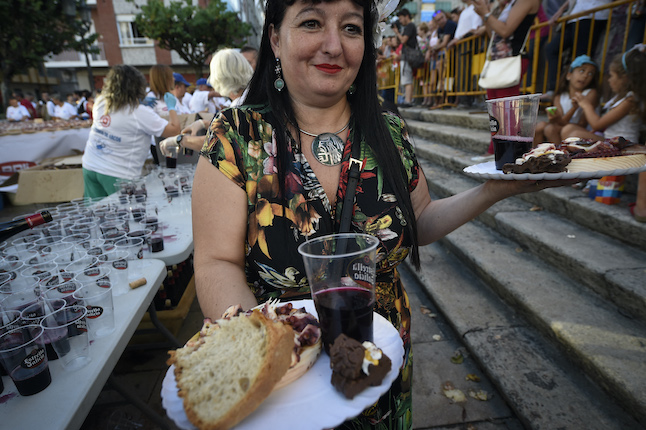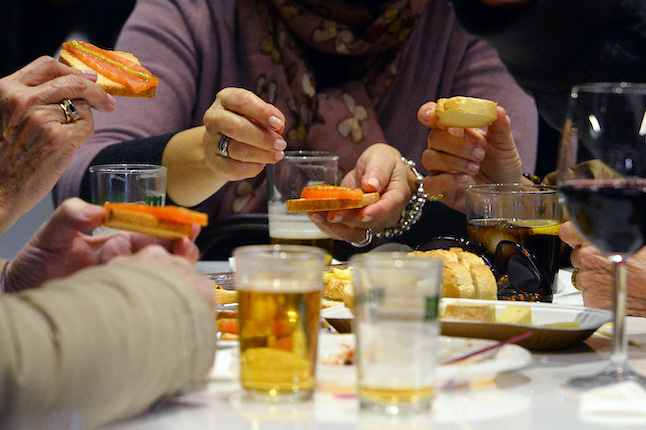Tapas are an important part of Spanish culture, not only because of the gastronomical aspect but because of the social aspect of sharing dishes too.
The word ‘tapa’ – meaning ‘lid’ – is thought to derive from a 13th-century law passed by a Castilian king requiring taverns to serve food with alcohol, perhaps in a bid to avoid inebriation of the serfs.
A ‘tapa’ was a small plate of ham or olives used as a lid to keep insects and dust away from a drink and usually came free.
The tradition of free tapas has died out across much of Spain, but there are still some cities where it is alive and well. Most of these cities can be found in three regions – the eastern part of Andalusia, Castilla y León and Galicia.
READ ALSO: Fourteen classic Spanish dishes to celebrate World Tapas Day
Granada
Granada is the undisputed king of free tapas in Spain, famed for its offerings which can be anything from a piece of Spanish tortilla to almost a whole meal, such as a mini burger and fries or small fried fish. It works like this – each time you buy a drink, you will be given a free tapas dish. If you order consecutive drinks in the same bar, each of the tapa dishes you get will be different. Free tapa will come with everything from beer and wine to soft drinks and sparkling water, but not with coffee or tea. Keep in mind that the price of drinks in Granada is slightly higher than in some Spanish cities, which helps to cover the cost of the food.
Calle Navas, Calle Virgen del Rosario and the area around the Cathedral offer some of the best tapas in the city. Remember that if you’re a vegetarian or vegan, ask for una tapa vegetariana o tapa vegana. While most bars in the city should have a suitable alternative, some of the more rough and ready ones might not, or you may just get something simple like bread and cheese. One of Granada’s best-loved vegetarian tapas dishes is berenjena con miel (deep fried aubergine drizzled with treacle).
READ ALSO: What to order at a restaurant in each region of Spain
Almería
Just southeast of Granada on the coast, Almería is another of Spain’s great free-tapas cities. The tradition is a little different here than in other Spanish cities because you get to choose your tapa instead of just getting a surprise. Many of the tapas menus here are vast and you’ll be spoilt for choice. It could be anything from a goat’s cheese and caramelised onion montadito (small sandwich) to paté on toast. Almeríans love their toast, so don’t be surprised if you find many different variations of topped toasts on the menu.
You’ll also have to speak up here, waiters will often come over to ask for your drink order, but not come back and ask for your tapa order. It’s best to tell your waiter what you want when your drinks arrive.

Jaén
The city and province of the same name to the north of Granada is also known for its tapa gratis when ordering a drink. Like in Granada, here you’ll be given the tapa of the house and generally won’t be given a choice in what you get. The prices of beers here are not as high as in Almería, but tapas portions are generally pretty generous, meaning you can easily have enough for dinner by going to just a few places.
Dishes here may include a plate of migas (fried breadcrumbs or flour with pieces of meat and fried peppers) or morcilla (blood sausage or black pudding). You can try asking for a vegetarian or vegan tapa here too, but the bars may not be as accommodating as the ones in Granada and may not have so many options, although they will try with what they have.
León
It’s not just the eastern provinces of Andalusia where you can get free tapas. One of the best foodie cities in northern Spain that has carried on this tradition is León. Some of the most typical tapas dishes you may be served here include patatas leonesas (León-style potatoes), or morcilla de León (blood sausage or black pudding from León).
During the pandemic, a few bars in León started charging around €0.30 to €0.50 for tapas, but you’ll be happy to know that the majority of them still offer it for free. Bars will generally charge less for the wine, beers and other drinks here than in Granada too. The best places to go are around the famed Barrio del Húmedo or the Barrio Romántico. There are even some bars that will offer free tapas with your coffee order for breakfast here, which is unheard of elsewhere.
Ávila
In almost every bar in Ávila you will be served a free tapa along with your drink. You’re unlikely to be served a simple piece of bread with a topping, here the dishes are almost like mini meals. Much of the cuisine here is based on meat, so you might expect a small plate of stewed wild boar or kidney with potatoes.
You will also find that they’re pretty big compared to free tapas in some other cities and filling too, but along with that, you will be paying slightly above average for your drink. The best street to head to for free tapas here is Calle San Segundo.
Alcalá de Henares
There may only be some bars left in Madrid that will offer you a free tapa with your drink, but head just east to the student town of Alcalá de Henares and you’ll find that they’re given out freely. Lots of places here will let you choose what you want too. You’ll pay above average for a caña here, around 3, but for that you’ll get a fairly decent tapa which could include patatas bravas, burgers or scrambled eggs with potatoes.
READ ALSO: Top ten Madrid bars serving free tapas, one for each barrio
Santiago de Compostela
When you’ve finally completed the Camino, what could be better than sitting down to a nice cold beer and plate of free tapas? The majority of bars here offer simple tapa such as a piece of bread with some type of meat on top, such as jamón or sausage or a small slice of tortilla de patatas (Spanish omelette).
Lugo
Another Galician place, known for offering free tapas is the walled city of Lugo. Here you’ll be given a free snack with your glass of Albariño wine or beer. Lugo’s tapas scene works differently from elsewhere too, here a waiter will come around with a tray of various types of dishes and you’ll select the one you like the look of best. These may include anything from pulpo (octopus) to empanadas (Galician-style pies), tortilla rellena (filled omelette) or anchoas (anchovies).



 Please whitelist us to continue reading.
Please whitelist us to continue reading.
Member comments